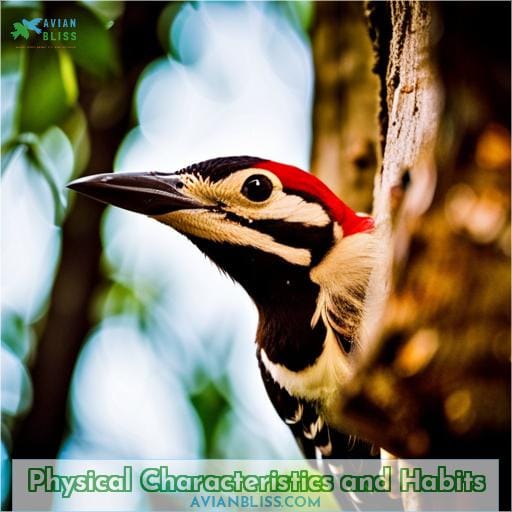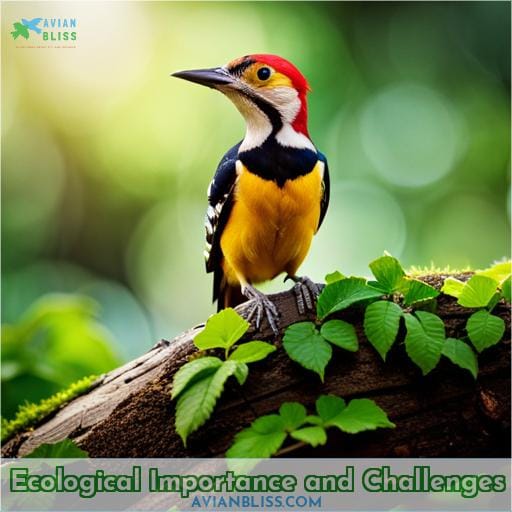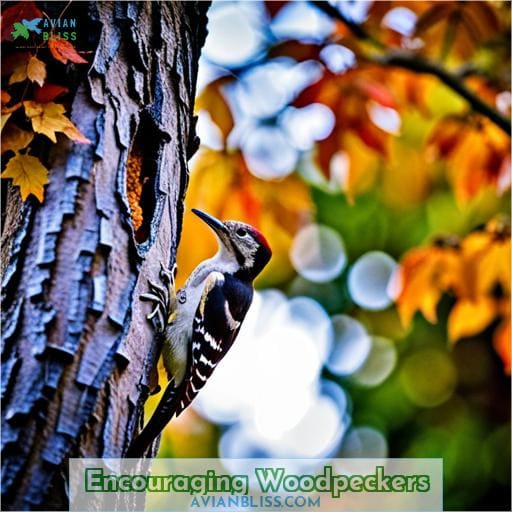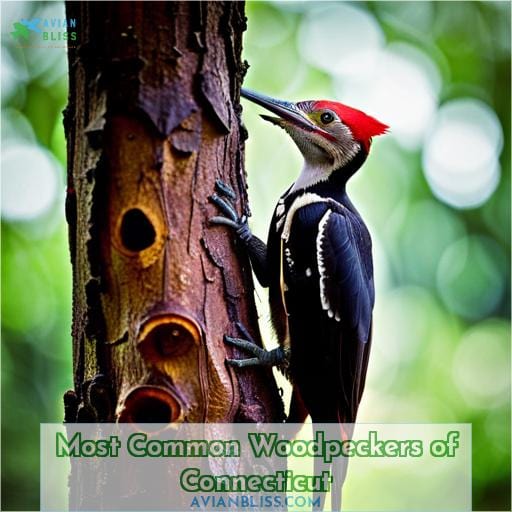This site is supported by our readers. We may earn a commission, at no cost to you, if you purchase through links.
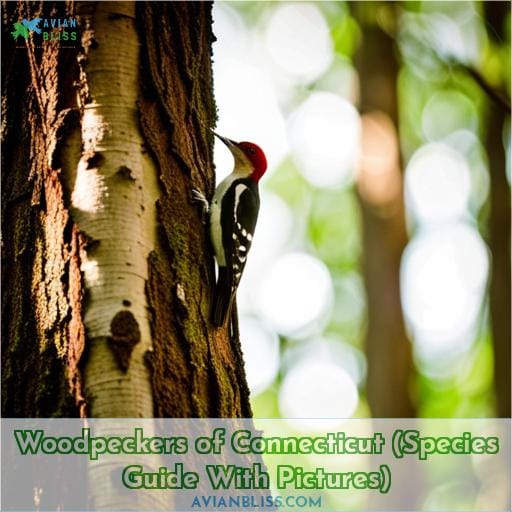
Here, a community thrives, bound not by blood or bone but instead by a shared reverence for age-old trees and the life they foster. Though fleeting in your sight, these avian architects are no phantoms; seven distinct woodpecker species nestle in Connecticut’s woods.
Armed with insight into their characteristics and habits, you too can decipher their taps. So come, let your eyes and ears lead you to discover these elusive drummers of the forest.
Table Of Contents
- Key Takeaways
- Woodpecker Species in Connecticut
- Physical Characteristics and Habits
- Ecological Importance and Challenges
- Encouraging Woodpeckers
- Most Common Woodpeckers of Connecticut
- Frequently Asked Questions (FAQs)
- How do woodpeckers’ feeding behaviors differ during the winter months in Connecticut?
- What is the significance of the drumming sound that woodpeckers create, and how does it vary among different species?
- Are there any natural predators that pose a threat to woodpecker nests and fledglings in Connecticut?
- How do woodpeckers contribute to the process of nutrient cycling within Connecticut’s ecosystems?
- What are some specific challenges faced by the Pileated Woodpecker, the largest woodpecker species in Connecticut, regarding finding suitable nesting sites?
- Conclusion
Key Takeaways
- Woodpeckers use rhythmic drumming for communication.
- Woodpeckers control insect populations by consuming wood-boring beetles, larvae, and sap feeders.
- Urbanization poses a threat to woodpecker habitats and forest health.
- Cultivating native fruit plants attracts woodpeckers and supports wildlife.
Woodpecker Species in Connecticut
Greetings bird enthusiast! As an ornithologist specializing in Connecticut’s diverse woodpecker species, I’m thrilled to share my in-depth knowledge of these remarkable birds.
You’ll be fascinated to learn about the seven species gracing our state. They include the dainty Downy Woodpecker, which gleans insects from bark crevices. There’s also the hefty Pileated Woodpecker, known for drilling for ants in decaying logs.
And let’s not forget the flashy Red-headed Woodpecker, which snatches fruits and berries from branches.
Each species boasts unique plumage, behaviors, habitat preferences, and specialized adaptations that enable their niche in Connecticut’s forests and woodlands. With ample opportunities to observe these energetic birds across the state, you’re sure to delight in spotting their snappy black-and-white plumage and hearing their distinctive drumming.
Let’s explore the world of Connecticut’s woodpeckers together!
Downy Woodpecker
You’ll spot the Downy Woodpecker’s black wings dotted with white as it taps on tree bark, foraging for hidden insects.
- Prefers deciduous forests with old trees
- Nesting cavities are 12-30 feet high
- Males drum to attract mates
- Feed on bark beetles, ants, caterpillars
Flitting between branches, this petite woodpecker blends into the trees as it pecks for insects. Flocking in family groups after nesting season, the Downy is a delightful sight in Connecticut’s forests.
Watch for its bobbing head and listen for its whinnying call to find this busy bird.
Hairy Woodpecker
You’d spot those black wings with white spots pecking for larvae deep in an old oak’s bark crevices. Resting after finding sustenance, this bird’s red crest catches your eye. Watching more closely, you notice matching red patches atop its head.
The stripes and vibrancy denote a male hairy woodpecker. You ponder the role this bird plays in the forest ecosystem, controlling pests while excavating nests for other species.
Yellow-bellied Sapsucker
You could observe a medium-sized, 7-9 inch Yellow-bellied Sapsucker preferring forests and feeding on sap, insects, and fruit while drilling sap wells into tree trunks in Connecticut’s woodlands. The sapsucker’s sap wells benefit trees through pruning and insect control. Outer tail feathers aid climbing.
Sapsucker drumming on branches advertises territory. Avoid felling old-growth trees which provide nesting habitat. Instead, install nest boxes to attract these forest residents. Their presence indicates healthy, biodiverse ecosystems.
Northern Flicker
After the Yellow-bellied Sapsucker comes the Northern Flicker, a medium-large woodpecker around 12 inches long that prefers open country near large trees where it can eat ants, seeds, and fruit while nesting in decaying trees or broken trunks, laying 5-10 white eggs that will fledge in about 4 weeks.
The Northern Flicker has a unique drumming pattern that resonates through the forest as it searches for ants deep underground using its specialized tongue. Skillfully excavating nest cavities high up in snags, it competes with other woodpeckers like the Red-bellied for prime nesting sites filled with larvae and nuts.
Red-bellied Woodpecker
Y’all nest in dead trees or live trees with dead limbs, laying 4-5 white eggs that incubate for 11-14 days. We often spot your flashy red-headed cousins pecking on the side of houses, but you prefer mature forests and woodlands.
Your red belly blazes as you balance upside down, pecking for insects or excavating a nest cavity. Come spring, we love watching your swooping courtship flights and drumming on branches to attract a mate.
Cavity nesters like y’all keep forests healthy by creating homes for other wildlife after y’all move on.
Pileated Woodpecker
The king-sized Pileated, Connecticut’s mightiest woodpecker, hammers sap-laden treats from towering trunks. As you gaze upward, watching this crow-sized bird, note its flaming red cap and sweeping white lines accenting jet black and white plumage.
Marvel at how its strong bill chisels rectangular holes seeking carpenter ants deep within disease-riddled oaks. Picture its excavated nest, lined with wood chips, harboring tiny peeping chicks. Though urbanization threatens, robust populations persist where forests allow. Appreciate this charismatic bird’s unique role in enriching our state’s biodiversity.
Red-headed Woodpecker
With its fiery red head and neck, you’ll recognize this woodpecker as it forages for insects, berries, and nuts in open deciduous forests and old fields. Windy tendencies bring the red-headed woodpecker‘s striking colors to your attention.
Distinctive courtship displays in spring reveal regeneration possibilities if preservation efforts for old, open habitats s쳮d. Unique climbing adaptations like specialized toes enable probing into trees despite the distinctive, elongated bill.
Identifying the emphatic tchurr-tchurr call hints at this woodpecker’s presence and your need to provide habitat mitigating loss.
Physical Characteristics and Habits
As Connecticut woodpeckers come in many sizes and plumages, you’ll find the Downy foraging along trunks with white stripes on black wings while the Hairy probes old wood with its chisel bill for beetle larvae.
The Downy Woodpecker is the smallest at 6-7 inches with black and white barred wings.
The Hairy Woodpecker is medium-sized at 9-10 inches with all black wings.
The Yellow-bellied Sapsucker drills sap wells and has a yellow wash on its belly.
The Northern Flicker feeds on ants on the ground and has speckled plumage.
The Pileated Woodpecker is the largest at 16-19 inches with a prominent red crest.
With a mix of habitats from forests to backyards, Connecticut attracts an array of these specialized birds. Their adaptations like chisel bills and long tongues allow them to probe bark and extract insects.
Understanding the differences in size, plumage, and behavior among woodpeckers takes patience and a good pair of binoculars.
With keen observation, you’ll come to recognize their signature calls and flight patterns around the state.
Ecological Importance and Challenges
Hello there, as someone who has extensively studied woodpecker species here in Connecticut, I’d like to give you some insight into their important ecological roles and the challenges they face. These specialized cavity excavators control insect populations and provide crucial nest sites for other species, yet also depend on ample forest habitat that is dwindling from urban sprawl.
Role in Controlling Insect Populations
You’ll see woodpeckers gobbling up those bugs in your backyard. Their rapid drumming and acrobatic maneuvers showcase a voracious appetite for wood-boring beetles, tree sap feeders, and larvae concealed in bark crevices.
We’re fortunate beneficiaries of their pest control services. Woodpeckers help regulate insect populations that damage trees, promoting forest health through sustainable recycling of deadwood resources.
Their specialized skills reveal interconnections in nature’s complex web. Appreciate their role in your habitat by providing suet, nest boxes, and native plants that nourish all wildlife.
Nesting Cavities Benefitting Other Birds and Mammals
You’re peeping those drilled holes high up the trunk, hoping a chickadee or nuthatch will move into the abandoned nest. Those woodpeckers are like little carpenters, excavating cozy cavities in decaying trees that smaller birds can move right into.
Their industrious chiseling provides shelter for all kinds of critters to raise their young, from bluebirds to flying squirrels. Without those ecosystem engineers, there’d be far fewer nesting sites in the forests of North America.
That’s why we gotta protect their habitat and put up more nest boxes to keep attracting woodpeckers.
Aiding in Forest Health
Don’t you wonder how they assist the forest’s well-being by controlling insects and creating additional habitats?
- Excavating nesting cavities provides shelter for many forest animals.
- Feeding on wood-boring beetles controls tree pests.
- Spreading fungal spores aids decomposition.
- Caching acorns contributes to oak regeneration.
Woodpeckers benefit forests through pest control, shelter provision, nutrient cycling, and seed dispersal.
Habitat Loss Due to Urbanization
You’ve witnessed birds migrating as forests are replaced by neighborhoods and malls.
| Species | Population Trend | Key Threats |
|---|---|---|
| Downy Woodpecker | Declining | Habitat loss from development |
| Hairy Woodpecker | Stable | Fragmentation of mature forests |
| Red-headed Woodpecker | Declining | Loss of oak savannas |
As natural areas are transformed into concrete jungles, many woodpeckers lose their habitats. Promoting sustainable growth and involving communities in protecting green spaces can help restore the lost habitats.
Although it may seem challenging, with a commitment to nature, even bustling towns can provide shelter for native birds.
Encouraging Woodpeckers
As an experienced Connecticut ornithologist, I recommend supporting our local woodpecker populations by providing suet and sunflower seeds, installing nest boxes, and cultivating native fruit plants. These simple actions create suitable habitats and attract these charismatic birds to backyards and neighborhoods across the state.
Providing Suet and Sunflower Seeds
Hang up suet feeders and keep ’em stocked to draw in woodpeckers y’all want to see.
Hang insect houses in trees to provide natural sources of protein.
Offer sunflower seeds and nut feeders for essential fats and calories.
Cultivate native fruit trees like oak and cherry for natural sugars.
Providing suet and sunflower seeds gives woodpeckers the high-energy foods they need.
Frequent feeding keeps them returning to your yard.
Save fruit trees by allowing some dead wood to stand.
Woodpeckers appreciate the insects that live in snags.
Meet their needs, and they’ll bring color and activity to your little corner of Connecticut.
Installing Nest Boxes
Let nest boxes invite new tenants while you watch woodpeckers raise their young. Choose nest box designs with entrance holes fitting the head sizes of target woodpecker species. Add metal shields to deter larger predators. Mimic natural cavity conditions using rough interior walls or natural wood chips.
Apply slippery barriers below boxes to foil climbing snakes. Site boxes away from trees where Yellow-bellied Sapsuckers drill sap wells. Observe antics like the black and white striped heads of Downies as adults feed nestlings, decoding the Morse code-like drumming that echoes woodpecker characteristics.
Cultivating Native Fruit Plants
Plant some serviceberry trees to attract woodpeckers with their early spring flowers and fruits. Native options like dogwoods, viburnums, and chokeberries provide berries throughout the seasons. Leave dead trees and stumps, which make great feeding stations. Let leaf litter accumulate to encourage insects.
Most Common Woodpeckers of Connecticut
Connecticut is home to several common woodpecker species that frequent backyards and woodlands. As an ornithologist in the state, I often observe Downy Woodpeckers foraging on tree trunks, huge Pileated Woodpeckers hammering on dead trees, and Red-bellied Woodpeckers feeding on suet at feeders.
Downy Woodpeckers
You’d put up a suet feeder to attract the little downies. Their foraging acrobatics on tree trunks and branches delight birdwatchers. Listen for their drumming as they excavate nests in dead limbs. In April, watch the dedicated parents take turns incubating eggs.
By June, downy fledglings leave the nest, still begging to be fed. Patiently observe these smallest woodpeckers thriving in forests or your backyard.
Pileated Woodpeckers
Check out this double-cake pileated suet feeder to attract one of Connecticut’s largest woodpeckers to your yard. As the state’s most majestic woodpecker, pileateds require extensive forests to thrive.
Installing suet feeders can supplement their diet, especially in winter when insects are scarce. While providing food is helpful, preserving large tracts of oak and pine is crucial for these habitat specialists facing development pressures.
Promoting sustainable land use helps secure the future for these keystone excavators whose nesting cavities benefit many species.
Red-bellied Woodpeckers
Those blazing ruby bellies streaking across your yard likely belong to Connecticut’s medium-sized giant of the woodlands, the red-bellied woodpecker, so commonly seen excavating decaying snags for its nest.
Strategically place suet feeders near tree trunks to draw them in while protecting your home. Though noisy, these efficient excavators aid decomposition and pest control. Their adaptability bodes well for stable populations if deadwood habitat persists.
Frequently Asked Questions (FAQs)
How do woodpeckers’ feeding behaviors differ during the winter months in Connecticut?
During Connecticut’s winter, woodpeckers adapt their feeding strategies. They focus on insects hidden beneath bark and in tree crevices, which is crucial in cold months.
What is the significance of the drumming sound that woodpeckers create, and how does it vary among different species?
The rhythmic drumming of woodpeckers resonates like a forest symphony, a primal percussion that echoes their presence. This unique beat serves as a multifaceted language: a territorial declaration, a courtship serenade, and an insect-hunting strategy.
Each species boasts its signature rhythm, from the flamboyant Pileated’s thunderous cadence to the Downy’s delicate tap, tailored to its habitat and intentions. This drumming, a secretive conversation hidden in plain sound waves, underscores woodpeckers’ mastery of communication in their woodland realm.
Are there any natural predators that pose a threat to woodpecker nests and fledglings in Connecticut?
Woodpecker nests and fledglings face threats from predators like squirrels, raccoons, and snakes. These skilled predators target eggs and young birds. Vigilant parents protect their brood, showcasing nature’s drama in Connecticut’s woodlands.
How do woodpeckers contribute to the process of nutrient cycling within Connecticut’s ecosystems?
Woodpeckers, essential players in Connecticut’s ecosystems, aid in nutrient cycling. By foraging for insects from trees, they stimulate decomposition. Nest cavities host diverse life. Your landscape nurtures their vitality, fostering a harmonious connection with nature.
What are some specific challenges faced by the Pileated Woodpecker, the largest woodpecker species in Connecticut, regarding finding suitable nesting sites?
Seeking refuge high above, the mighty Pileated Woodpecker navigates Connecticut’s vast forests in search of suitable nesting sites. The challenge lies in finding towering trees, essential for their grandeur and thriving kin.
Conclusion
Through their dancing drumrolls and acrobatic antics, Connecticut’s woodpeckers captivate us. As an ornithologist who has spent decades studying these charismatic caviomorphs in the field, I’ve witnessed firsthand their vital role in our forests’ health.
Though habitat loss poses a serious threat, we can support our Downy, Pileated, and Red-bellied woodpeckers by nurturing natural spaces. If we heed the call of these feathered foresters, a brighter future awaits. Their rhythmic rat-a-tats remind us – preserve wilderness, and the woodpeckers of Connecticut will thrive for generations to come.


